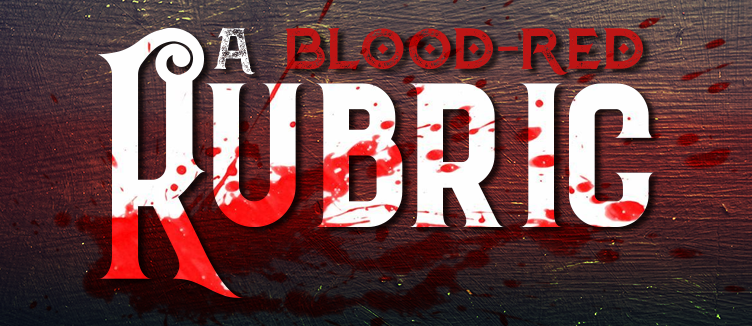You can check the completed conversion out here. I may yet lay them out more properly if there is any demand.
I haven't had the chance to test the conversions out, but I should get my first opportunity on Monday when the party takes their first step through Ultan's Door and into the sewers of Zyan.
One thing that doing this project has really drive home to me is just how boring I find monsters in 5E. Ultimately, a lot of the conversions actually have more abilities than their OSR-style counterparts but they feel less interesting in some way. I find that 5E stat blocks sit in an uncomfortable position between Classic D&D stats and 4E stat blocks.
Classic D&D stat blocks are short, and intended for generally quick and lethal combat. The monsters don't need a ton of stuff to do because they aren't going to be on screen for long enough for it to matter. In addition, the simple stat block feel ripe with opportunities to improvise, because the relatively simplicity (not quite the right word, but HD and highly constrained AC/to-hit maths provide some simple guideposts) of the maths makes adjudicating novel actions relatively easy.
By contrast, 4E stat blocks are much more detailed, but they also provide everything needed to run a monster that has a defined role in an encounter, and at least one or two tricks that will make them memorable and feel different from other monsters.
In 5E stat blocks, you get a large amount of detail but there usually isn't much there in terms of memorable tricks or unique abilities. Usually there's just AC, some HP, an attack or two that does HP damage. Occasionally there is the odd interesting special ability, but not much that changes the tactical situation.
It feels like the worst of both worlds where the monster is designed with a Classic D&D mentality in terms of how complex its abilities need to be, combined with a very detailed stat block, and the fact that combats lasts longer and the monsters takes up more screen time.
5E's task resolution systems mean that you need all that additional stat block detail to resolve improvised actions, but that extra detail doesn't come with the benefit of more interesting mechanical game play. Whereas, I would argue, 4E's more complex stat blocks do meaningfully add to the tactical combat elements of the game.
I have tried to find some opportunities to add a few unique abilities, but 5E's "natural language" approach and monster design philosophy doesn't give the design language or mechanical tools that I would like for those sorts of things. I also feel a little bit weird assigning gimmicks to Ben L's creations without more input from him because if those unique abilities are properly designed they can imply a lot about monster and its place in the world.
For what it is worth, I think that Kobold Press do a much better job with this kind of monster design in their Tome of Beasts and Creature Codex products.
Anyways, enough waffle from me, here are a couple of the conversions:
The Sweating Maiden
Medium construct, unaligned
Armor Class 14
Hit points 35
Speed 30ft.
Senses passive perception 10
Languages -
Challenge 2
Saves Dex +3, other saves +0
Actions
Bladed Parasol. Melee Weapon Attack: +5 to hit, reach 5ft., one target.
Hit: 15 (3d6 +5) slashing damage.
Reactions
Parry. The Maiden adds 4 to is AC against one ranged attack that would hit it. To do so, the Maiden must see the attacker and be wielding the Bladed Parasol. The first time the Maiden takes this reaction each round, it does not use up its reaction.
The Groomsman
Medium construct, unaligned
Armor Class 14
Hit points 35
Speed 30ft.
Senses passive perception 10
Languages -
Challenge 2
Saves Dex +3, other saves +0
Whirling Dance. The Groomsman may take a bonus action on each of its turns in combat. This action can be used only to take the Dash or Disengage action.
Actions
Multiattack. The Groomsman makes two Scissor Stilts attacks.
Scissor Stilts. Melee Weapon Attack: +5 to hit, reach 10ft., one target.
Hit: 9 (2d6 +2) piercing damage.
Shadow Puppet Sorcerer
Medium elemental, chaotic
Armor Class 13
Hit points 1
Speed 30ft.
Damage immunities poison, psychic
Condition immunities blinded, charmed, deafened, frightened, grappled, poisoned, restrained, stunned, unconscious.
Senses darkvision 120ft., passive perception 13
Languages -
Challenge 1
Number 1
Saves Dex +5, other saves +0
Skills
- moving silently, blending into shadow +7.
Shadow Body. If a Shadow Puppet starts its turn in light shed by the Light or Sunlight spells (or similar magical illumination), it must succeed on a DC 14 Constitution saving throw or be destroyed.
Innate Spellcasting. The Shadow Puppet's innate spellcasting ability is Charisma (spell save DC 11, +3 to hit with magical attacks). It can cast the following spells, requiring no material components, only by taking the Random Spellcasting action on its turn.
At will: darkness, magic missile, phantasmal force, stinking cloud
Actions
Random Spellcasting. The Shadow Puppet Sorcerer casts one of the following spells (roll a d4):
- darkness
- magic missile
- phantasmal force
- stinking cloud

